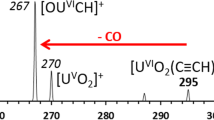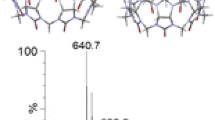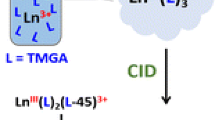Abstract
Electrospray ionization of actinyl perchlorate solutions in H2O with 5% by volume of dimethylformamide (DMF) produced the isolatable gas-phase complexes, [AnVIO2(DMF)3(H2O)]2+ and [AnVIO2(DMF)4]2+, where An = U, Np, and Pu. Collision-induced dissociation confirmed the composition of the dipositive coordination complexes, and produced doubly- and singly-charged fragment ions. The fragmentation products reveal differences in underlying chemistries of uranyl, neptunyl, and plutonyl, including the lower stability of Np(VI) and Pu(VI) compared with U(VI).
Similar content being viewed by others
1 Introduction
The chemistry of the early actinides, from thorium to americium, is of particular technological and scientific significance [1]. The linear, hexavalent actinyl ions, {O=AnVI=O}2+, are important in solution chemistry of U [2], Np [3] and Pu [4]. The americyl ion, AmVIO 2+2 , is a stable species in solution but is not predominant under most conditions [5]. The uranyl ion is particularly prevalent and has been extensively studied by both experiment and theory [6]. The transfer of monopositive pentavalent UVO +2 from solution to the gas phase using electrospray ionization (ESI) was first reported in 1992 [7]. Since then, use of ESI has been expanded to allow generation of a wide range of pentavalent and hexavalent uranyl ions, monopositve and dipositive, by ESI [8–12] and, in turn, has allowed investigation of intrinsic uranyl coordination chemistry. Of particular relevance to the present work, ESI of solutions of uranyl in water/acetone and water/acetonitrile have revealed the affinity of gas-phase uranyl for more basic organic ligands and penta-coordination, as in [UVIO2(CH3COCH3)5]2+ and [UVIO2(CH3CN)5]2+ [12, 13].
Stability of the dipositive actinyl ions in solution decreases following the trend [14]: UVIO 2+2 >> PuVIO 2+2 > NpVIO 2+2 > AmVIO 2+2 . Although UVIO 2+2 ligated by basic electron-donating ligands has been sufficiently stabilized to enable its transfer from solution to the gas phase, it does not necessarily follow that the less stable dipositive actinyl ions can be similarly transferred from solution to gas. The standard reduction potentials for AnVIO 2+2 → AnVO +2 are: 0.09 V for UVIO 2+2 ; 0.95 V for PuVIO 2+2 ; 1.16 V for NpVIO 2+2 ; and 1.60 V for AmVIO 2+2 [15]. It is evident that relative to UVIO 2+2 , the other three AnVIO 2+2 should be prone to reduction during ESI.
Early plutonium ESI/MS work focused on the speciation of Pu(IV) in the gas phase [16, 17]. The first report appeared in 2003, where ESI/MS was used to identify the molecular structure of radiolytic products of irradiated TRPO-kerosene systems [16]. More recently, Walther et al. employed ESI/MS to characterize tetravalent plutonium polymer growth [18].
Recently, we reported transfer of solvent-coordinated PuVIO 2+2 ions from solution to the gas phase by ESI of plutonyl in acetone/water and acetonitrile/water [19]. Ion complexes were isolated in an ion trap for mass analysis and collision-induced dissociation (CID). Parallel studies of uranyl revealed inherent differences between the coordination and redox chemistries of Pu and U in the gas phase. In the initial study, attempts to transfer NpVIO 2+2 from solution to the gas phase, using acetonitrile or acetone as co-solvent (and as basic ligands to stabilize dipositive gas-phase complex ions), were unsuccessful. As we report here, use of the more basic ligand dimethylformamide (DMF) allows for transfer of divalent NpVIO 2+2 complexes to the gas phase. This has enabled the first comparison of the gas-phase behavior of uranyl, neptunyl, and plutonyl complexes with identical ligand composition and coordination number.
2 Experimental Methods
Uranyl, neptunyl, and plutonyl solutions in DMF/water were prepared at a concentration of 80 μM in an organic solvent/water ratio of 5/95 from actinyl perchlorate stock solutions in water. The actinide isotopes employed were U-238, Np-237, and Pu-242. All handling of these hazardous radionuclides was in a containment glove box in a radiological laboratory. The ESI/MS and CID experiments were performed with an Agilent 6340 Quadrupole Ion Trap (QIT) mass spectrometer, with the ESI source housed within a radiological-containment glove box. In high resolution mode, the instrument has a detection range of m/z 50–2200 and a resolution of m/z ~0.25 (full width half maximum). Mass spectra were recorded in the positive ion accumulation and detection mode using instrumental parameters similar to those employed in our earlier study of PuVIO 2+2 species [19].
Solutions were injected into the electrospray capillary via a syringe pump at a rate of 60 μL/h. Nitrogen gas was used for nebulization and drying in the ion transfer capillary. CID experiments were performed using the He trapping gas at a pressure of ~10–4 Torr; tickle voltages ranged between 0.1 V and 1.0 V applied for 40 ms. The background water pressure in the ion trap was ~10–6 Torr.
3 Results and Discussion
Our hypothesis was that DMF as the co-solvent, with a gas-phase basicity of 857 kJ/mol, compared to basicities of 660, 748, and 782 kJ/mol, for water, acetonitrile, and acetone, respectively [20], would facilitate transfer of dipositive NpVIO 2+2 complexes to the gas phase. Indeed, ESI generated a range of monopositive and dipositive complexes containing 238UVIO 2+2 , 237NpVIO 2+2 or 242PuVIO 2+2 (spectra not shown). The monopositive complexes included DMF-, or DMF- and H2O-coordinated AnVO +2 (An = U, Np, or Pu) complexes with between 1 and 3 ligands, or for the case of U, solvent-coordinated UVIO2OH+ species. The compositions of all of the actinyl ion complexes, some of which were of low intensity, were definitively confirmed by CID fragmentation as described below. Of particular interest in this study were the dipositive species, of which the most abundant were those with compositions [AnVIO2(DMF)4]2+ and [AnVIO2(DMF)3(H2O)]2+. The abundances of the uranyl complexes were much greater than those of the neptunyl and plutonyl complexes, typically by about an order of magnitude. Unlike earlier experiments focusing on uranyl and plutonyl complexes with acetonitrile or acetone ligands, formation of gas-phase species containing 238UVIO 2+2 , 237NpVIO 2+2 , or 242PuVIO 2+2 coordinated by five DMF ligands was not observed. The bond energy should decrease with increasing ligand number [21], and the high basicity of DMF relative to acetonitrile or acetone should result in greater electron donation to the metal center by the first four ligands, which may render addition of a fifth DMF ligand energetically unfavorable. Similar shifts to higher stability of complexes with four ligands relative to those with five have been observed previously with gas-phase uranyl-nitrile complexes [12].
Figure 1 shows the CID spectrum produced from [AnVIO2(DMF)4]2+, An = U, Np, and Pu, precursor ions. In each spectrum, abnormal artifact peaks, the origins of which are unknown, were observed in the region of the precursor and doubly-charged product ions. These are marked in Figures 1, 2 and 3 by asterisks, and a version of the spectra with expanded m/z axis is shown in Figure S1 to demonstrate that precursor and product ion peaks can be distinguished from the artifact peaks. For [UVIO2(DMF)4]2+ (Figure 1a), fragmentation was dominated by formation of (doubly-charged) [UVIO2(DMF)3]2+ and [UVIO2(DMF)3(H2O)]2+ at m/z 244.5 and 253.5, respectively. Water-containing species such as [UVIO2(DMF)3(H2O)]2+ were produced by hydration of an under-coordinated CID product, in this case [UVIO2(DMF)3]2+. Singly-charged product ions such as [UVIO2OH(DMF)2]+ (m/z 364) were generated at less than 1% relative intensity.
CID (MS/MS stage) of (a) [UO2(DMF)4]2+, (b) [NpO2(DMF)4]2+, and (c) [PuO2(DMF)4]2+. Asterisked features are artifacts (see Figure S1). Species containing water were produced by hydration of primary CID products in the ion trap
CID (MS3 stage) of (a) [UO2(DMF)3]2+, (b) [NpO2(DMF)3]2+, and (c) [PuO2(DMF)3]2+ generated from CID of [AnO2(DMF)4]2+. Asterisked features are artifacts (see Figure S1). Species containing water were produced by hydration in the ion trap
CID (MS3 stage) of (a) [UO2(DMF)3(H2O)]2+, (b) [NpO2(DMF)3(H2O)]2+, and (c) [PuO2(DMF)3(H2O)]2+. These ions were generated from CID of [AnO2(DMF)4]2+ and hydration of the [AnO2(DMF)3]2+ products. Asterisked features are artifacts (see Figure S1)
CID spectra of [AnVIO2(DMF)4]2+ for An = Np and Pu are shown in Figure 1b and c, respectively. Doubly-charged product ions included [AnVIO2(DMF)3]2+ and [AnVIO2(DMF)3(H2O)]2+ at m/z 244 and 253 for 237NpVIO 2+2 and m/z 246.5 and 255.5 for 242PuVIO 2+2 . Unlike the case for the uranyl complexes with DMF, CID of the neptunyl and plutonyl complexes generated abundant monopositive product ions. For both, prominent [AnVO2(DMF)]+ and [AnVO2(DMF)2]+ species appeared at m/z 342 and 415 for neptunium, and m/z 347 and 420 for plutonium. The singly-charged product ions for the neptunyl and plutonyl precursors were ca. two orders of magnitude more abundant than those for the corresponding uranyl precursor; these results reflect the greater propensity of NpVI and PuVI to reduce to the pentavalent oxidation state as compared with more stable UVI.
The [AnVIO2(DMF)3]2+ product species from dissociation of each actinyl complex was isolated and subjected to a subsequent CID stage (Figure 2). Each of these species, during isolation for CID, formed the hydrated, doubly charged [AnVIO2(DMF)3(H2O)]2+ ion (m/z 253.5, 253, and 255.5 for An = U, Np, and Pu, respectively). In addition, the singly-charged [AnVO2(DMF)]+ and [AnVO2(DMF)2]+ CID products were also generated for An = Np and Pu. For [NpVIO2(DMF)3]2+, a peak at m/z 73 was also observed in the CID spectrum, which corresponds to the radical cation DMF+. This species in particular is consistent with oxidative elimination of a ligand during the formation of the monopositive [AnVO2(DMF)]+ and [AnVO2(DMF)2]+ product ions.
Sufficient intensities of the [AnVIO2(DMF)3(H2O)]2+ ions were generated by CID (and hydration) to allow investigation of secondary CID (Figure 3). For [UVIO2(DMF)3(H2O)]2+ (Figure 3a), elimination of H2O followed by rapid re-addition of indigenous H2O was observed: this leads to re-generation of the precursor, which manifests as an apparent “steady state” of precursor ion with increasing applied collision voltage or CID duration. This same phenomenon was observed for each [AnVIO2(DMF)3(H2O)]2+ precursor and reflects the rapid ligand addition rates for the hypo-coordinated dipositive complexes with only three coordinating ligands [5e, 6]. The dominant singly-charged product ions observed for [UVIO2(DMF)3(H2O)]2+ were protonated DMF, (DMF+H)+, at m/z 74 and [UVIO2OH(DMF)2]+ at m/z 433. The reduced species [UVO2(DMF)]+ and the species [UVIO2OH(DMF)]+ were observed at less than 1% relative intensity. The prominent peaks at m/z 74 and 433 in the CID spectrum of [UVIO2(DMF)3(H2O)]2+ are consistent with a hydrolysis reaction activated by CID in which the bound H2O ligand is split, with elimination of a DMF ligand in protonated form, and retention of hydroxide anion by the uranyl dication.
The CID spectrum of [UVIO2(DMF)3(H2O)]2+ contrasts sharply with the product ion spectra for [NpVIO2(DMF)3(H2O)]2+ and [PuVIO2(DMF)3(H2O)]2+ (Figure 3b and c, respectively), for which the reduced [AnVO2(DMF)]+ and [AnVO2(DMF)2]+ were dominant. Instead of ligated hydroxides, H2O adducts of the reduced [AnVO2(DMF)]+ and [AnVO2(DMF)2]+ products were observed at m/z 360 and 365 for Np and Pu, respectively.
The CID results are summarized in Scheme 1, where gas-phase hydration and hydrolysis processes are included along with CID fragmentation processes. A striking aspect of these results is that the uranyl(VI) oxidation state is retained to a greater extent than either neptunyl(VI) or plutonyl(VI), which is in accord with condensed phase actinyl oxidation/reduction behavior [14, 15].
Overall, the ESI mass spectrometry and CID results confirm the transfer of dipositive, hexavalent actinyl complexes of 238UVIO 2+2 , 237NpVIO 2+2 , or 242PuVIO 2+2 with DMF to the gas phase. This is the first report of such transfer of dipositive neptunyl complexes to the gas phase. As the electron affinities of NpVIO 2+2 and PuVIO 2+2 are comparable (15.1 ± 0.4 eV) [22] and are at least 2 eV greater than the ionization energies (IEs) of water (12.6 eV) and DMF (9.12 eV) [20], stabilization of dipositive actinyl ions against electron transfer from these neutrals requires charge donation by coordinating ligands. Coordination of the actinyl by electron-donating ligands reduces the effective electron affinity of the complexed dipositive ion such that charge exchange is not energetically favorable. The results suggest that four basic ligands are needed to stabilize dipositive actinyl ions in the gas phase, and that more nucleophilic DMF ligands are more effective than water at stabilizing dipositive ions, in general, in the gas phase. At least three DMF ligands, along with either a fourth DMF or a water, were necessary for the generation of sufficient neptunyl complexes for CID study.
References
Katz, J.J., Morss, L.R., Edelstein, N.M., Fuger, J.: The Chemistry of the Actinide and Transactinide Elements, 3rd edn. Springer, Dordrecht (2006). Chapter 1
Grenthe, I., Drozdzynski, J., Fujino, T., Buck, E.C., Albrecht-Schmitt, T.E., Wolf, S.F.: The Chemistry of the Actinide and Transactinide Elements, 3rd edn. Springer, Dordrecht (2006). Chapter 5
Yoshida, Z., Johnson, S.G., Kimura, T., Krsul, J.: The Chemistry of the Actinide and Transactinide Elements, 3rd edn. Springer, Dordrecht (2006). Chapter 6
Clark, D.L., Hecker, S.S., Jarvinen, G.D., Neu, M.P.: The Chemistry of the Actinide and Transactinide Elements, 3rd edn. Springer, Dordrecht (2006). Chapter 7
Runde, W.H., Schulz, W.W.: The Chemistry of the Actinide and Transactinide Elements, 3rd edn. Springer, Dordrecht (2006). Chapter 8
Denning, R.G.: Electronic, Structure and Bonding in Actinyl Ions and their Analogs. J. Phys. Chem. A 111(20), 4125–4143 (2007)
Agnes, G.R., Horlick, G.: Electrospray Mass Spectrometry as a Technique for Elemental Analysis: Preliminary Results. Appl. Spectrosc. 46(3), 401–406 (1992)
Pasilis, S.P., Pemberton, J.E.: Speciation and Coordination Chemistry of Uranyl(VI)−Citrate Complexes in Aqueous Solution. Inorg. Chem. 42(21), 6793–6800 (2003)
Pasilis, S.P., Somogyi, A., Herrmann, K., Pemberton, J.E.: Ions Generated from Uranyl Nitrate Solutions by Electrospray Ionization (ESI) and Detected with Fourier Transform Ion-Cyclotron Resonance (FT-ICR) Mass Spectrometry. J. Am. Soc. Mass. Spectrom. 17(2), 230–240 (2006)
Chien, W., Anbalagan, V., Zandler, M., Van Stipdonk, M.J., Hanna, D., Gresham, G., Groenewold, G.S.: Intrinsic Hydration of Monopositive Uranyl Hydroxide, Nitrate, and Acetate Cations. J. Am. Soc. Mass. Spectrom. 15(6), 777–783 (2004)
Van Stipdonk, M.J., Anbalagan, V., Chien, W., Gresham, G., Groenewold, G.S., Hanna, D.: Elucidation of the Collision Induced Dissociation Pathways of Water and Alcohol Coordinated Complexes Containing the Uranyl Cation. J. Am. Soc. Mass. Spectrom. 14(11), 1205–1214 (2003)
Van Stipdonk, M.J., Chien, W., Bulleigh, K., Wu, Q., Groenewold, G.S.: Gas-Phase Uranyl–Nitrile Complex Ions. J. Phys. Chem. A 110(3), 959–970 (2006)
Van Stipdonk, M.J., Chien, W., Anbalagn, V., Bulleigh, K., Hanna, D., Groenewold, G.S.: Gas-Phase Complexes Containing the Uranyl Ion and Acetone. J. Phys. Chem. A 108, 10448–10457 (2004)
Choppin, G.R., Jensen, M.P.: The Chemistry of the Actinide and Transactinide Elements, 3rd edn. Springer, Dordrecht (2006). Chapter 23
Konings, R.J.M., Morss, L.R., Fuger, J.: The Chemistry of the Actinide and Transactinide Elements, 3rd edn. Springer, Dordrecht (2006). Chapter 19
Ping, Z., Song, C.L., Liang, J.F., Xin, R.X.: Identification of Radiolytic Degradation Products of γ-Irradiated 30% Trialkylphosphine Oxide-Kerosene Solution Solvent Extract. Ion Exchange 21(1), 91–108 (2003)
Francis, A.J., Dodge, C.J., Gillow, J.B.: Biotransformation of Plutonium Complexed with Citric Acid. Radiochim. Acta 94, 731–737 (2006)
Walther, C., Rothe, J., Brendebach, B., Fuss, M., Altmaier, M., Marquardt, C.M., Büchner, S., Cho, H.-R., Yun, J.-I., Seibert, A.: New Insights in the Formation Processes of Pu(IV) Colloids. Radiochim. Acta 97, 199–207 (2009)
Rios, D., Rutkowski, P.X., Van Stipdonk, M.J., Gibson, J.K.: Gas-Phase Coordination Complexes of Dipositive Plutonyl, PuO 2+2 : Chemical Diversity Across the Actinyl Series. Inorg. Chem. 50, 4781–4790 (2011)
NIST Chemistry WebBook – NIST Standard Reference Database Number 69 – March, 2003 Release, Ionization Energies data compiled by Lias, S. G.; Rosenstock, H. M.; Draxl, K.; Steiner, B. W., Herron, J. T., Holmes, J. L., Levin, R. D., Liebman, J. F., Kafafi, S. A.(eds.) US Department of Commerce: Washington, DC, 2003. Available from: http://webbook.nist.gov/chemistry/
Schoendorff, G., Windus, T.L., de Jong, W.A.: Density Functional Studies on the Complexation and Spectroscopy of Uranyl Ligated with Acetonitrile and Acetone Derivatives. J. Phys. Chem. A 113, 12525–12531 (2009)
Marçalo, J., Gibson, J.K.: Gas-Phase Energetics of Actinide Oxides: An Assessment of Neutral and Cationic Monoxides and Dioxides from Thorium to Curium. J. Phys. Chem. A 113, 12599–12606 (2009)
Acknowledgments
The authors acknowledge support for this work by the Director, Office of Science, Office of Basic Energy Sciences, Division of Chemical Sciences, Geosciences, and Biosciences of the U.S. Department of Energy at LBNL, under contract no. DE-AC02-05CH11231. Work by M.V.S. was supported in part by a grant from the U.S. National Science Foundation (NSF grant CAREER-0239800).
Author information
Authors and Affiliations
Corresponding author
Electronic supplementary materials
Below is the link to the electronic supplementary material.
Figure S1
Expanded view of CID (MS/MS stage) spectra for (a) [UO2(DMF)4]2+, (b) [NpO2(DMF)4]2+, and (c) [PuO2(DMF)4]2+. Asterisked features are abnormal artifacts as evident from the peak shapes. Species containing water were produced by rapid hydration of primary CID products in the ion trap. (DOC 106 kb)
Rights and permissions
About this article
Cite this article
Rutkowski, P.X., Rios, D., Gibson, J.K. et al. Gas-Phase Coordination Complexes of UVIO 2+2 , NpVIO 2+2 , and PuVIO 2+2 with Dimethylformamide. J. Am. Soc. Mass Spectrom. 22, 2042–2048 (2011). https://doi.org/10.1007/s13361-011-0226-5
Received:
Revised:
Accepted:
Published:
Issue Date:
DOI: https://doi.org/10.1007/s13361-011-0226-5








